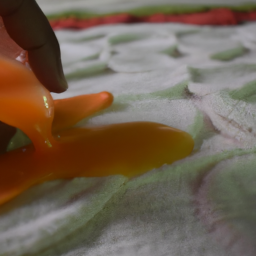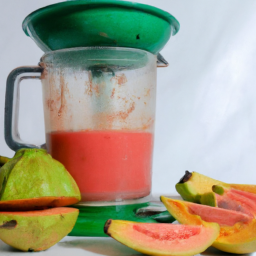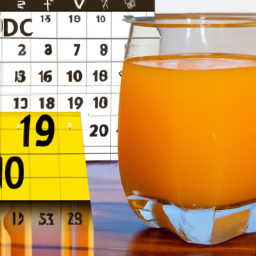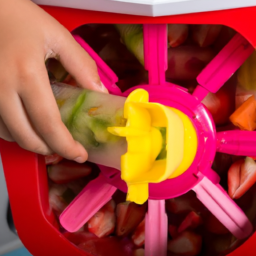Getting cranberry juice on your favorite shirt or carpet can be a real nightmare. The vibrant red color often leaves a stubborn stain that seems to never go away. But fear not, I have some effective methods to help you tackle those cranberry juice stains.
First and foremost, it’s important to assess the damage and act quickly. The longer the stain sits, the harder it will be to remove. So, as soon as you notice the spill, grab some supplies and get to work.
With a bit of patience and determination, you’ll be able to get that pesky cranberry juice out in no time. Keep reading for my step-by-step guide on how to do just that.
Key Takeaways
- Quick action is important when dealing with cranberry juice stains.
- There are various cleaning solutions that are effective, such as vinegar, baking soda, and stain removers.
- Different surfaces require different cleaning methods and it’s important to test stain removers on a small, inconspicuous area first.
- Being proactive and using spill-resistant materials can prevent future stains.
Assess the Damage and Act Quickly
You’ll want to assess the damage and act quickly if you’ve spilled cranberry juice, as it can leave a stubborn stain if left untreated. The first thing to do is to quickly grab a clean cloth or paper towel and blot the area, being careful not to scrub the stain as this will only make it worse.
This quick response will prevent the juice from penetrating deeper into the fibers of the fabric, making it easier to remove. Once you’ve blotted up as much of the juice as possible, it’s time to start treating the stain with cleaning solutions.
There are many products available that are specifically designed to remove stubborn stains like cranberry juice, but you can also use household items like vinegar or baking soda. The key is to apply the cleaning solution to the stain and let it sit for a few minutes before rinsing it off with cold water.
Speaking of which, the next step is to use cold water to continue the stain removal process.
Use Cold Water
Using cold water can work wonders in removing that stubborn cranberry juice stain, so don’t hesitate to give it a try! Not only is it an effective and easy method, but it also has several benefits worth noting.
Here are three reasons why using cold water is a great choice:
- It’s gentle: Unlike hot water, which can set the stain into the fabric, cold water is gentle and won’t damage your clothing or upholstery.
- It’s easily accessible: You don’t need any special tools or cleaning products to use cold water. Simply turn on the tap and you’re good to go.
- It’s cost-effective: Using cold water is a budget-friendly option that won’t break the bank.
Aside from its stain-removing properties, cranberry juice also has other uses, such as promoting urinary tract health and preventing certain types of infections. However, when it comes to getting rid of that pesky stain, cold water is the way to go.
Transitioning into the next section, it’s important to note that while cold water can do wonders, sometimes it’s not enough. In these cases, it’s time to apply a stain remover.
Apply a Stain Remover
Now it’s time to tackle that stubborn stain with a stain remover, and luckily, it’s a simple process that will have your clothes looking as good as new. When it comes to stain removers, there are a few different types to choose from. The most common types include enzymatic cleaners, oxygen-based cleaners, and solvent-based cleaners.
Enzymatic cleaners are great for removing organic stains, such as those caused by wine or fruit juice. Oxygen-based cleaners work well on a variety of stains, including cranberry juice, and are also environmentally friendly. Solvent-based cleaners are best for oil-based stains, such as those caused by makeup or grease. Whichever type of stain remover you choose, it’s important to follow the best practices for using stain removers. This includes reading the instructions carefully, testing the product on a small, inconspicuous area first, and avoiding rubbing the stain, which can cause it to spread.
Now that we’ve covered stain removers, it’s time to move on to another effective method for removing cranberry juice stains – using vinegar.
Use Vinegar
Feeling frustrated with the stubborn stain on your favorite shirt? Don’t worry, there’s a simple solution – vinegar.
Vinegar is a highly effective natural cleaning agent that can remove even the most stubborn stains. It’s a great alternative to harsh chemicals and has several benefits when used for cleaning. Not only is it safe for the environment, but it’s also much cheaper than most commercial cleaning products.
One of the benefits of using vinegar for cleaning is that it’s a natural disinfectant. It can kill bacteria, viruses, and mold, making it a great choice for cleaning surfaces in your home. Additionally, vinegar has a strong acidic nature, which makes it effective in breaking down stains and removing dirt.
There are several vinegar-based cleaning hacks that you can try, such as using it to clean your windows or remove hard water stains from your showerhead.
If vinegar doesn’t work for you, don’t worry. There are other effective ways to get cranberry juice out of your clothes. One such method is using baking soda.
Use Baking Soda
When it comes to removing cranberry juice stains, I’ve found that baking soda can be a game-changer.
To use it, I create a paste by mixing baking soda with a small amount of water. Then, I sprinkle the paste onto the stain and let it sit for about 10-15 minutes before wiping it away with a damp cloth.
This method works particularly well on fabric and can help lift even the most stubborn stains.
Create a Paste
To extract cranberry juice stains, you can create a paste using baking soda and water. This alternative method is effective in removing the stubborn stains without causing any damage to the fabric. Here’s how to make the paste:
| Baking Soda | Water |
|---|---|
| 2 tbsp | 1 tbsp |
Mix baking soda and water in a small bowl to form a paste. The consistency should be thick enough to spread over the stain. Using a spoon, apply the paste onto the cranberry juice stain, making sure to cover it completely. Let the paste sit for at least 30 minutes or until it dries. Once dry, scrape off the paste using a dull knife or spoon. Rinse the fabric with cold water to remove any remaining residue.
To continue the cleaning process, sprinkle baking soda onto the dampened area and rub it gently. This will help loosen any remaining stain particles and deodorize the fabric.
Sprinkle Baking Soda
Now that we’ve created a paste to remove cranberry juice stains, let’s move on to another effective solution. Don’t worry if you don’t have baking soda at home, there are other baking soda alternatives that can get the job done.
One of them is cornstarch. Simply sprinkle cornstarch on the stained area and let it sit for a few minutes before using a damp cloth to wipe it away. Another alternative is white vinegar. Mix equal parts of white vinegar and water, apply it to the stain, and let it sit for a few minutes before rinsing it off with warm water.
It’s important to note that different surfaces require different cleaning methods. For example, if you spilled cranberry juice on a carpet, you should blot the stain with a clean cloth or paper towel to remove as much juice as possible before applying any cleaning solution. On the other hand, if you spilled it on a hard surface like a countertop or table, you can directly apply the baking soda or any other cleaning solution.
Now that we’ve covered another effective solution for cleaning cranberry juice stains, let’s move on to the next step, which involves using salt.
Use Salt
So, here’s what I know about getting cranberry juice stains out using salt. First, you can create a salt solution by mixing salt and warm water.
This solution is then poured directly onto the stain and left to sit for a few minutes before being rinsed off with cold water. Alternatively, you can apply salt directly onto the stain, rubbing it in gently until the stain starts to lift, and then rinsing it with cold water.
Create a Salt Solution
Mixing salt with water to create a solution is rumored to be effective in removing cranberry juice stains. The benefits of using a salt solution for cleaning are numerous.
Not only is salt an inexpensive and easily accessible ingredient, but it’s also a natural and eco-friendly option. Salt is known for its abrasive properties, which make it an effective cleaning agent. When mixed with water, salt creates a solution with a gritty texture that can scrub away tough stains like cranberry juice.
Aside from its use in cleaning solutions, salt has alternative uses that make it a versatile household item. For example, salt can be used to deodorize and freshen up carpets and rugs by sprinkling it on the surface and letting it sit for a few hours before vacuuming. Additionally, salt can be used to remove rust stains from metal surfaces.
Simply mix salt with lemon juice to create a paste, apply it to the rust stain, and let it sit for a few hours before wiping it away. With all of these benefits, it’s no wonder that salt is a popular choice for those looking to tackle tough cleaning challenges.
Moving on to the next section, let’s explore how to apply salt directly to a cranberry juice stain.
Apply Salt Directly
To effectively remove a tough cranberry juice stain, you’ll want to apply salt directly to the affected area. Salt is an excellent natural abrasive that can help break down the stain and lift it from the fabric. There are many benefits of using salt for stain removal, including its versatility and affordability. Salt can be used on a variety of fabrics and surfaces, making it a go-to solution for many different types of stains. Additionally, salt is readily available in most households, so you won’t need to make a special trip to the store to purchase it.
While there are alternatives to using salt for stain removal, they may not be as effective. For example, some people recommend using baking soda or vinegar to remove cranberry juice stains. While these methods may work in some cases, they may not be as efficient as salt. Additionally, they may not be as gentle on delicate fabrics, which could result in further damage to the item. Overall, using salt is a safe and effective method for removing cranberry juice stains. In the next section, we’ll discuss how to use hydrogen peroxide to further lift the stain.
Use Hydrogen Peroxide
Using hydrogen peroxide can be a lifesaver when it comes to removing stubborn cranberry juice stains. One of the benefits of hydrogen peroxide is that it’s a powerful oxidizer, which means it can break down and lift even the toughest stains.
To use hydrogen peroxide for removing cranberry juice stains, simply pour a small amount onto the affected area and let it sit for a few minutes. Then, use a clean cloth to blot the stain, working from the outside in to prevent it from spreading. Rinse the area thoroughly with cold water and repeat the process if necessary.
If you don’t have hydrogen peroxide on hand, there are other alternatives to consider. One option is using white vinegar and baking soda. Mix a small amount of baking soda with vinegar to create a paste, then apply it to the stain and let it sit for a few minutes before rinsing with cold water. Another alternative is to use rubbing alcohol. Dab a small amount onto a clean cloth and gently blot the stain, then rinse with cold water. However, it’s important to note that these methods may not be as effective as hydrogen peroxide in removing stubborn cranberry juice stains.
While hydrogen peroxide is a reliable method for removing cranberry juice stains, there are other natural options to consider. One of these is using lemon juice, which can be just as effective and leave a fresh scent behind.
Use Lemon Juice
You can easily remove those stubborn stains with just a squeeze of fresh lemon juice. Lemon juice is a natural alternative to chemical-based stain removers that can be harsh on fabrics and surfaces.
Here are a few benefits of using lemon juice for cleaning:
-
Natural bleaching agent: Lemon juice contains citric acid, which can lighten and brighten fabrics and surfaces.
-
Pleasant scent: Lemon juice leaves behind a fresh, citrusy scent that can help to mask unpleasant odors.
-
Cost-effective: Lemons are inexpensive and readily available, making lemon juice an affordable option for stain removal.
If you don’t have fresh lemon juice on hand, there are other lemon juice alternatives for stain removal, such as bottled lemon juice or lemon essential oil. However, be sure to dilute these alternatives with water to avoid damaging fabrics or surfaces.
Now that you know the benefits of using lemon juice for cleaning, let’s move on to the next step: using enzyme cleaners.
Use Enzyme Cleaners
When it comes to getting cranberry juice out of clothing or fabric, using an enzyme cleaner can be an effective solution.
The first step is to choose the right enzyme cleaner for the job, as different types of cleaners are designed to target specific stains.
Once you have the right cleaner, apply it directly to the affected area and let it sit for a few minutes before washing the item as usual.
Choose the Right Enzyme Cleaner
To effectively remove cranberry juice stains, consider picking an enzyme cleaner that contains protease enzymes. These enzymes break down protein-based stains like cranberry juice, and can make the cleaning process much easier.
There are many types of enzyme cleaners available in the market, some of which are specifically formulated for protein-based stains. When choosing an enzyme cleaner, it’s important to read the label carefully and look for one that lists protease enzymes as an active ingredient.
Once you’ve chosen the right enzyme cleaner, it’s important to properly apply it to the stain. First, blot up any excess juice with a clean cloth. Then, saturate the stain with the enzyme cleaner and let it sit for at least 15 minutes to allow the enzymes to work their magic.
After the allotted time, rinse the area thoroughly with warm water. Repeat the process if necessary until the stain is completely removed. With the right enzyme cleaner and proper application, you can easily remove cranberry juice stains from almost any surface.
Now, let’s move on to the next step and learn how to apply the enzyme cleaner directly.
Apply Enzyme Cleaner Directly
If you’re struggling with a protein-based stain, such as blood or food, using an enzyme cleaner can be an effective solution. Enzyme cleaners contain specific enzymes that break down the proteins in the stain, making it easier to remove. However, it’s important to note that not all enzyme cleaners are created equal. Different enzymes work on different types of stains, so it’s crucial to choose the right cleaner for the job.
When using an enzyme cleaner, it’s best to apply it directly to the stain and let it sit for the recommended amount of time. This allows the enzymes to break down the proteins and loosen the stain from the fabric. It’s important to choose an enzyme cleaner that is safe for the type of fabric you’re working with, as certain enzymes can damage delicate materials.
By using enzyme cleaners for non-cranberry stains, you can effectively remove stubborn stains and prolong the life of your clothing.
To prevent future stains, it’s important to take preventative measures such as wearing an apron while cooking or using a stain repellent spray on your clothing. By being proactive, you can avoid the frustration and hassle of trying to remove stubborn stains in the future.
Prevent Future Stains
One simple way to avoid future stains is by regularly wiping down the surfaces where spills occur. This can be done with a damp cloth or paper towel, and should be done immediately after any spills happen. By doing this, you can prevent the cranberry juice from seeping into the surface and causing a stain.
Another way to prevent future stains is by choosing spill-resistant surfaces. This can include materials such as granite, quartz, or porcelain, which are less porous and therefore less likely to absorb liquids. Additionally, you can use coasters or placemats to protect surfaces from spills.
By taking these preventative measures, you can ensure that your surfaces stay clean and stain-free.
Frequently Asked Questions
What are some common causes of cranberry juice stains?
I’ve found that common causes of cranberry juice stains include spills on porous surfaces, such as fabric or carpet, and failure to promptly treat the stain. Preventing stains involves immediate cleaning and using protective measures. Effective cleaning methods include using vinegar or enzymatic cleaners.
Can cranberry juice stains be removed from all types of fabrics?
Not all fabrics are created equal when it comes to stain removal techniques. You must consider the type of fabric before attempting any removal. Different fabrics require different treatments to avoid damage.
Is it safe to use hydrogen peroxide on colored fabrics?
Using hydrogen peroxide on colored fabrics has pros and cons. It can effectively remove stains, but may also cause discoloration. Alternatives to chemical stain removers include using vinegar or baking soda. Always test a small area first.
How long should I let the stain remover sit before washing the fabric?
When it comes to stain removal, pre-treatment techniques are crucial. Depending on the type of stain, letting the remover sit for at least 5-10 minutes before washing can increase the chances of success. Best laundry practices include using the hottest water recommended for the fabric and adding a high-quality laundry detergent.
Are there any natural alternatives to commercial stain removers for cranberry juice stains?
Oh, sure, because when I think of DIY stain removers and natural cleaning solutions, the first thing that comes to mind is cranberry juice stains. But in all seriousness, a mixture of vinegar and baking soda can do wonders for removing stubborn stains.
Conclusion
Well, folks, that’s how you can get cranberry juice out of just about anything! It’s not always easy, but with a little bit of persistence and some elbow grease, you can save your clothes, carpets, and furniture from the pesky stains that cranberry juice can leave behind.
Just remember to assess the damage quickly and act fast, and don’t be afraid to try out a variety of methods until you find the one that works best for you.
Whether it’s cold water, vinegar, baking soda, or lemon juice, there’s a solution out there that can get the job done.
So go forth and conquer those cranberry juice stains, my friends! With these tips, you’ll be a stain-fighting pro in no time. And who knows, you might even impress your friends with your newfound knowledge and skills.
After all, there’s nothing quite like the satisfaction of a job well done.
Ilana has been a vegan for over 10 years. She originally made the switch for health reasons, but soon found herself becoming more and more passionate about the ethical and environmental implications of a vegan lifestyle. Ilana is the author of The Graceful Kitchen, a blog all about veganism. She loves to cook up delicious and nutritious vegan meals, and share her recipes with others who are interested in leading a cruelty-free life. Ilana is also a strong advocate for using whole foods as the foundation of a healthy diet, and believes that going vegan is one of the best ways to achieve this.










